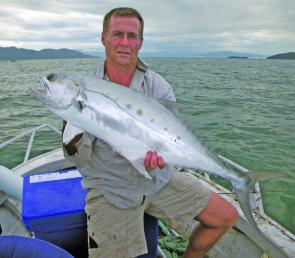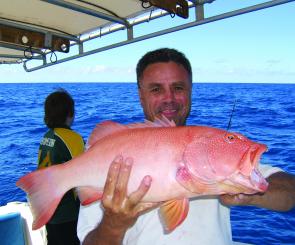With any luck, May will greet us with the start of the balmy northern winter weather. It’s been a long, exceptionally rainy, wet season and Cairns anglers are wishing for a few prolonged periods of clear blue skies.
The huge plus from the big wet has been the barra fishing, with many describing this year’s barra bonanza the best in living memory. Warm, still, days translate into a prolonged barra bite, so fingers crossed this will continue through May.
As the water temperatures drop, the smaller barra will settle into the freshwater weed beds and the bigger fish will congregate on deep water snags and along rock headlands and walls. The barra will search for patches of slightly warmer water, so with that in mind, go in search of water a degree or two warmer. If you have the technology, then the temperature gauge on your sounder will give you an accurate reading,
In the freshwater, shallow, sunny, weed beds will be a fraction warmer in the late afternoon, and are particularly attractive to juvenile barra, especially if they are near deeper water with good cover. The barra will hole up on the deep snags during the day and move out to feed in the warm shallow weed beds in the late afternoon.
The rock headlands and walls will heat up on the day time low tide, and the water will be a fraction warmer as the tide rises over the hot rocks. Look for barra at these locations when there is a late afternoon rising tide. Bigger barra will also go deep in the cooler weather and will be less active, so targeting deep water rock bars and snags could provide an angler with a lot of action
Trolling deep diving lures, with a keen eye on the sounder, will show you where the fish are sitting. You can then work that area over with lures, or anchor up and fish the structure with live prawns, sardines, mullet or pike. A dropper rig, with the bait about half a metre off the bottom, is a favourite set up for this technique.
The estuaries should be clearing and the salinity levels on the rise, so the queenfish and GTs will be moving into the river mouths on the top of the big tides. The last couple of hours of the run in tide and the first as the tide turns will be worth a look for these line burners.
Fishing at the mouth of the likes of the Russell/Mulgrave and Daintree rivers on the first weekend in May and again on the 14th and 15th will the best bet for picking up a fish.
Anchor upstream, and to one side of a drop-off and toss out a live sardine at right angles to the boat. Let it drift back around behind the boat with the current. Cast out then stick the rod in a holder and sit back and enjoy the magnificent view. Be sure to check the drag isn’t too tight, as these speeders love to burn off line after taking the bait. Repeat the cast and drift process every few minutes. Remember to retrieve the bait slowly or risk tearing the hook out.
When using live bait, a single 5/0 to 7/0 short shank hook through the clear gristle patch in front of the eye will allow the bait to swim freely and face straight into the current once behind the boat. Hooking the sardine in the traditional method, just behind the head and above the spine, isn’t effective in this context as the bait will spin in the current once it has drifted back behind the boat.
Use at least half a metre of 40lb fluorocarbon leader tied straight onto the braid or mono without a swivel to prevent a queenfish or GT biting through the line. If there is some really big GTs around, it may pay to go a bit longer on the leader to prevent cutting off on the tail rakes.
A double uni knot is ideal for tying leader to mono or leader to braid. When tying leader to mono, twist the tail through twice for the leader and four times for the mono. For braid, twist the leader through twice and the braid eight times.
Only feeding the leader through twice leaves the tag lying parallel to the main line when snugged down; whereas any more than two twists leaves it at right angles to the line and it catches more on runners when casting and retrieving.
If you are worried about the knot slipping, a drop of superglue will do the trick.
To cut the leader, I use pliers that sever by the two blades meeting, rather than passing each other like scissors. This leaves a slightly flattened end on the leader tag, preventing it from slipping through.
I also use a really hard leader like SureCatch fluorocarbon, which has a very good knot grip. Some softer leaders are far more slippery and will need the superglue to stop them slipping under load.
For some reason coral trout have been going off in the past couple of months. A lot of the speculation centres around the influence of Cyclone Yasi. Some believe damaged reefs and strong currents have caused the trout to relocate to the reefs off Cairns.
Needless to say, anglers are not complaining and there have been many reports of bag limits being reached. This is usually reserved for spring when the trout are feeding up in preparation for spawning. There have been great reports of reef fishing in general in the lead up to typing this report and weather permitting, May should continue to produce out wide.
The odd school mackerel should start to turn up at the harbour leads and around the local wrecks this month, especially if we get a patch of cooler weather. Dogtooth Tuna should be found in deeper water early in the season, so focus on fishing live sardines or pillies just off the bottom or set them up so they sink slowly to the bottom. This will give you the best chance to find out where they are feeding.
Sinking Bumpa Bar lures to the bottom, then working them erratically back to the surface can be a productive technique for snaring mackerel. It’s not uncommon to get hit on the drop using this technique, so preferably use braid for better feel. Let the lure sink with a finger on the line and be ready to strike and wind.
If the fishing matches the start to the year, then the historically more pleasant May weather should really put a smile on angler’s dials.
Reads: 2073
Terry McClelland, from Mareeba, with a good example of the silver acrobats that should start to show up in the river mouths this month, if the streams are clear.

Rob Cannon, from Cairns, with a sample of the barra that have been going off in recent months.

Pierre Fourie, from Cairns, with a beautifully coloured example of the coral trout that have been on the chew out from Cairns.




